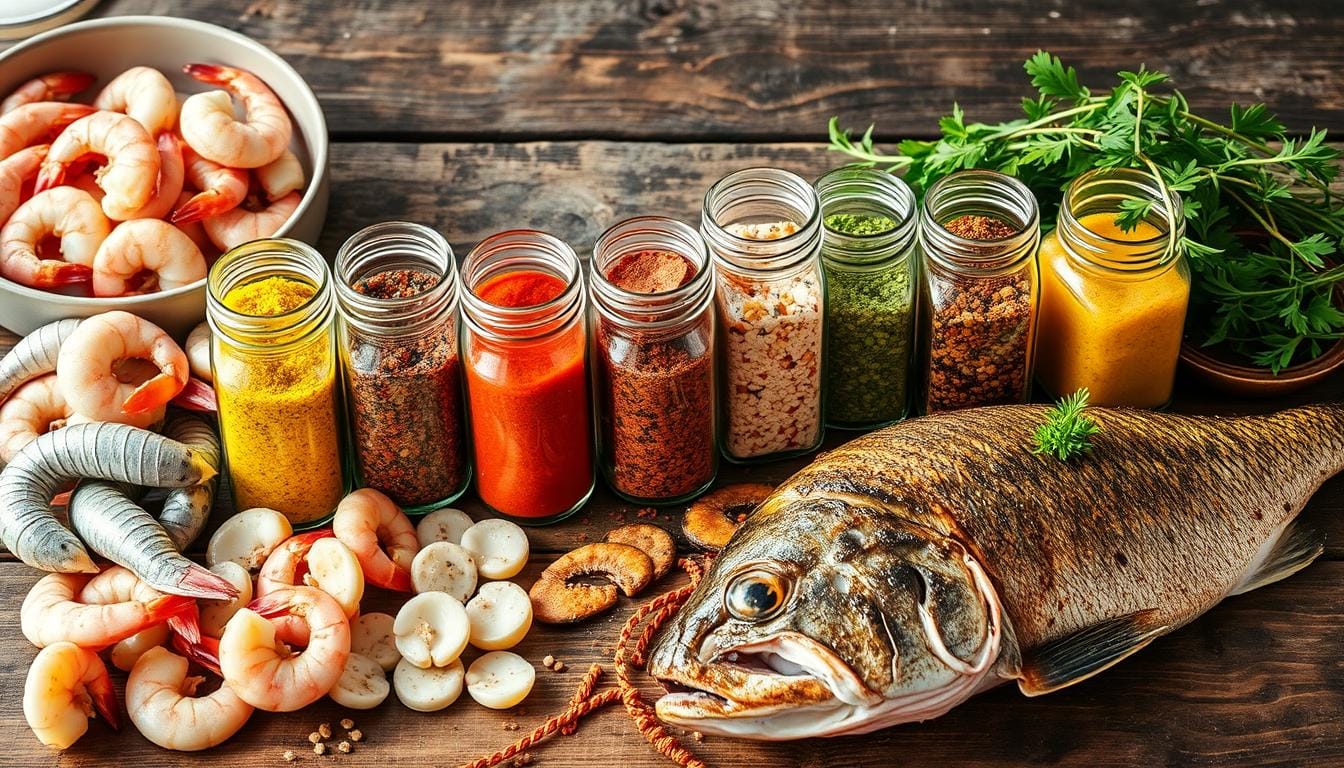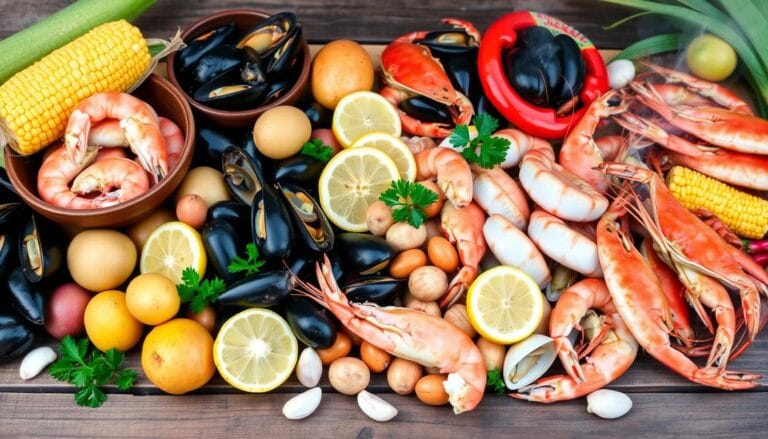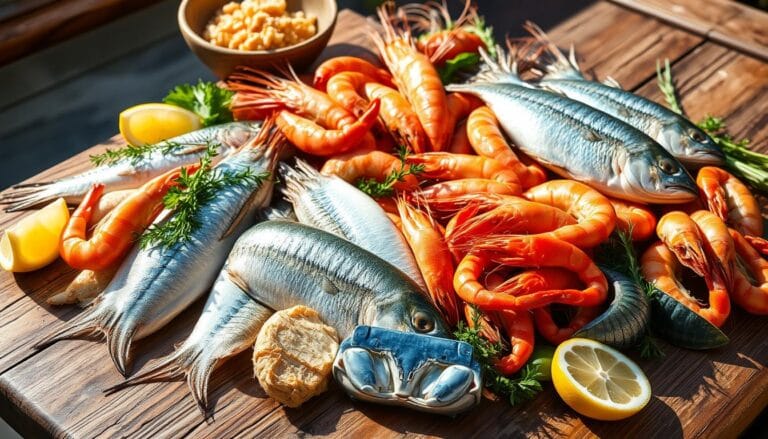Seafood Seasoning: 5 Best Blends for Flavorful Dishes
Imagine the joy of gathering around the dinner table. The aroma of freshly prepared fish fills the air. It brings back memories of sun-soaked shores and family barbecues.
With the right seafood seasoning, you can turn your meal into an unforgettable feast. Whether it’s the delicate taste of fish or the rich flavors of shellfish, the best seasoning is your secret. It adds depth and vibrancy to every bite.
As you start your culinary adventure, think about homemade seafood seasoning. A mix of spices like smoked paprika, garlic powder, and dried herbs like thyme and oregano can be tailored to your taste. This article will look at different seasoning options. You’ll find both homemade and store-bought choices to make your next seafood dish delicious and memorable.
Table of Contents
Introduction to Seafood Seasoning
Seafood seasoning is key in cooking, boosting the flavor of dishes. As people want fresh, quality seafood more, it’s becoming a mainstay in diets. It suits many tastes, making it popular worldwide. The right seasoning can make shrimp, lobster, or fish taste even better, keeping their natural flavors while adding a special aroma.
Many cooks buy mixes for ease. These mixes often have garlic, onion, and bay leaves, perfect for seafood boils. Others like making their own, letting them mix and match flavors.
Octopus and sea urchin are becoming more common on menus. Spicy seasonings, especially those with bold peppers, are a hit with seafood lovers. This trend encourages people to try new combinations, making seafood dishes more varied.
Now, many brands offer pre-seasoned, ready-to-cook seafood, appealing to those who care about the environment. The constant introduction of new flavors makes seafood cooking an adventure, making it fun to find the best seasoning.
Importance of Flavor in Seafood Dishes
Flavor is key in making seafood dishes great. Seafood often has a light taste, so using seafood seasoning is important. Spices like Old Bay, garlic powder, and lemon are popular in seafood boils.
Creating a great seafood dish means balancing flavors. Mixing garlic, onion, and bay leaves with spices can make a bold flavor. These spices also offer health benefits, like fighting inflammation and boosting metabolism.
Sauces are also crucial in adding flavor to seafood. French butter sauce and creamy lemon sauce can elevate your dishes. The right seasoning, like lemon zest and black pepper, makes seafood stand out.
Using fresh, quality ingredients is essential. They let the seafood’s natural taste shine. Try marinades with citrus and soy-ginger for extra flavor and tender seafood.
Being creative with flavors can make your seafood dishes unforgettable. The aim is to add to the seafood’s natural taste without overpowering it.
Understanding Different Types of Seafood Seasonings
Choosing the right seafood seasoning can really make your dishes taste better. You can pick from two main types: traditional seafood seasoning and spicy seafood seasoning. Each type adds its own special touch to seafood, making sure you find the perfect match for your cooking.
Traditional Seafood Seasoning
Traditional seafood seasoning mixes often include paprika, garlic powder, and celery salt. These blends aim to give a balanced flavor that goes well with many seafood types. Old Bay seasoning is a great example, known for its strong aroma.
Using traditional seafood seasoning adds a classic taste to fish fillets and shellfish. It’s a timeless choice that never goes out of style.
Spicy Seafood Seasoning Variants
If you like your food hot and full of flavor, try spicy seafood seasoning. These blends have cayenne pepper and blackening spices for a bold kick. Cajun seasoning is a top pick, offering strong flavors for shrimp, catfish, or grilled lobster tail.
Spicy seafood seasoning adds a thrilling twist to your dishes. It makes them stand out and leaves a lasting impression.
Top Ingredients for Homemade Seafood Seasoning
Making your own seafood seasoning can change how you enjoy fish and shellfish. By mixing common pantry items and choosing the right spices, you can make a seasoning that brings out the best in seafood. Knowing the key ingredients is the first step to creating the perfect blend.
Common Pantry Staples
Many essential ingredients for homemade seafood seasoning are already in your kitchen. Here are a few basics:
- Garlic powder
- Onion powder
- Smoked paprika
- Celery salt
- Ground black pepper
These ingredients are the foundation of a delicious seasoning. They add depth and aroma to every seafood dish.
Spices That Elevate Flavor
To take your seasoning to the next level, add spices that offer unique flavors and scents. Some great options are:
- Dried thyme
- Ground cumin
- Crushed red pepper flakes for heat
- Dill weed
- Ground cloves
Try different spice combinations to find the perfect match for your taste and the seafood you’re using. For example, adding more dry mustard or swapping some celery salt for seeds can really change the flavor.
Best Seafood Seasoning Blends Available
There are many seafood seasoning blends to choose from. They can make your cooking better. Look for the top-rated seafood seasoning options. These blends offer unique tastes for different seafood:
- Lemon Herb: This blend has dried lemon zest, parsley, thyme, oregano, garlic powder, salt, and pepper.
- Cajun: It’s a mix of paprika, cayenne pepper, garlic powder, onion powder, thyme, oregano, and black pepper.
- Garlic Butter: It includes garlic powder, butter powder, parsley, thyme, oregano, or chives. It’s great for a rich taste.
- Asian Sesame Rub: It has toasted sesame seeds, ginger, garlic powder, red pepper flakes, and sometimes sugar or soy sauce. It adds an Asian twist.
- Cilantro Lime: It features dried cilantro, lime zest, garlic powder, cumin, chili powder, and salt. It brings bright flavors to your dishes.
When picking a seafood seasoning blend, think about the seafood you’re cooking. Lemon herb is good for salmon, while Cajun is great for shrimp or catfish. Each blend is a great way to boost your seafood’s natural taste.
How to Make Your Own Seafood Seasoning
Making your own seafood seasoning can make your dishes taste better. It lets you choose the spices you like. This way, you can create the perfect mix for your cooking.
Easy Seafood Seasoning Recipe
This recipe makes about 1 cup of seasoning in just 5 minutes. You’ll need:
- 2 tablespoons smoked paprika
- 1 tablespoon garlic powder
- 1 tablespoon onion powder
- 1 tablespoon celery seed
- 1 tablespoon mustard powder
- 1 tablespoon black pepper
- 1 teaspoon cayenne pepper
- 2 tablespoons fine sea salt
- 1 tablespoon dried thyme
- 1 tablespoon ground coriander seed
Mix all the spices together until they’re well combined. This mix makes 16 servings. Each serving has about 21 calories, 3g carbs, 1g protein, and 1g fat. Keep it in a cool, dry place for up to six months.
Customizing Your Blend
You can change the spices to fit your taste. Add more cayenne for heat or more thyme for a fresher taste. This lets you control the salt and spice levels in your food.
Homemade seasoning is cheaper than store-bought. It’s also healthier because it has less salt and no preservatives. You can use it in many dishes, like breading, pasta sauces, or as a dipping sauce.
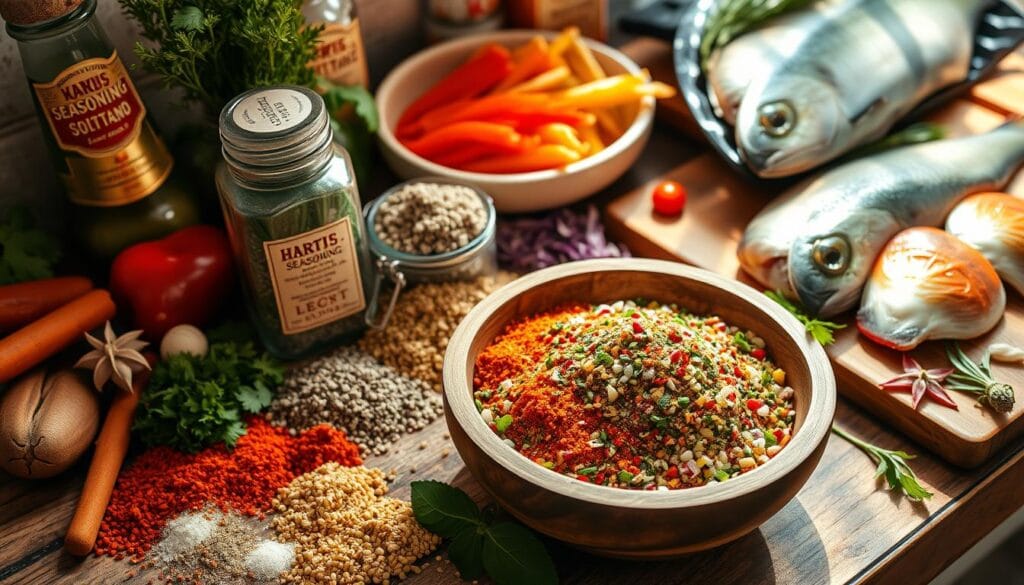
Using Seafood Seasoning for Fish
Adding seafood seasoning to fish is a simple way to make your meals better. Just sprinkle the seasoning over the fish before cooking. Use 1 tablespoon of seasoning for every half pound of fish. This helps keep the fish’s natural taste while adding flavor.
Marinades can also add flavor and moisture to the fish. Let the fish marinate for at least 30 minutes. Even 15 minutes can improve the taste.
Choosing the right seasoning blend is key. A mix with smoked paprika, garlic powder, and thyme can make a great crust. Look for a balance that enhances the fish’s taste without overpowering it.
Try different seasonings and marinating times to find what you like best. Enjoy exploring flavors and making your dishes even better.
Using Seafood Seasoning for Shellfish
When cooking shellfish, the right seasoning is key. Shrimp, clams, and scallops taste great with the right seasoning. It’s important to use a light touch to let their natural sweetness shine.
Grilling or sautéing shellfish can be made even better with flavorful blends. Old Bay seasoning is a classic choice that adds a comforting taste. Zatarain’s Crawfish, Shrimp, and Crab Boil seasoning brings a spicy kick to your dish.
Here are some tips for the best flavor:
- Lightly season your shellfish with seafood seasoning for shellfish before cooking.
- When preparing a seafood boil, consider incorporating various ingredients like lemon, bay leaves, and your choice of spices.
- Cook in stages to ensure that all ingredients achieve the perfect doneness.
Remember, a light touch with seasoning lets the shellfish’s natural flavors stand out. This results in a balanced and delicious meal.
Health Benefits of Homemade Seafood Seasoning
Making your own seafood seasoning has many benefits. You can choose fresh, healthy ingredients. This adds both taste and nutrition to your seafood dishes.
Control Over Ingredients
When you make your own seasoning, you control what’s in it. You can pick spices like turmeric, garlic, and ginger. These add great flavor and have health benefits.
They help fight inflammation and boost brain health. By avoiding store-bought blends, you skip unhealthy additives. This makes your meals cleaner and healthier.
Avoiding Additives and Preservatives
Commercial seasonings often have preservatives to last longer. Making your own seasoning means no bad chemicals. Ingredients like cumin and fennel help your digestion and keep seafood fresh.
Spices like oregano and thyme also fight off harmful bacteria. This makes your food safer and reduces the chance of contamination.
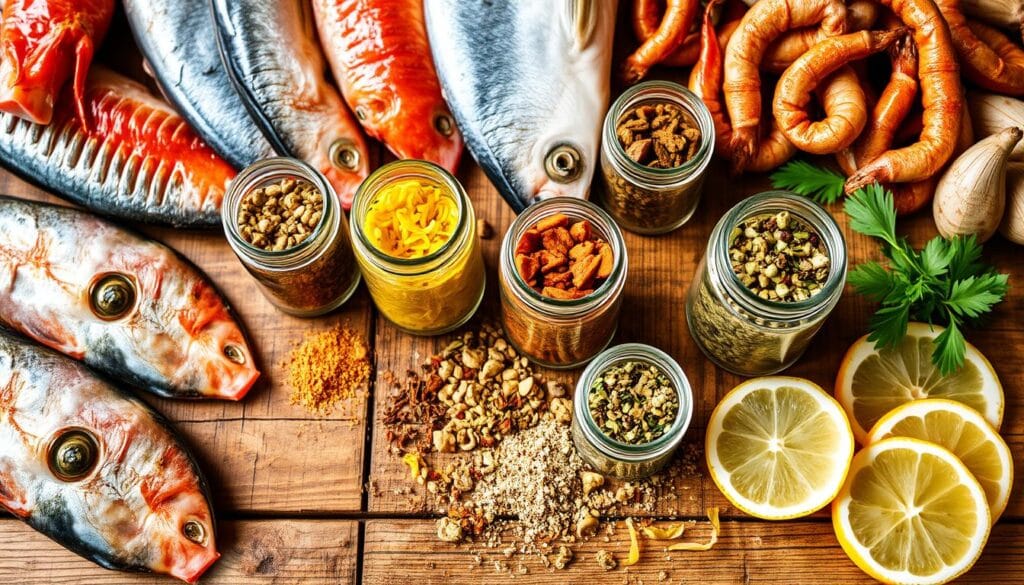
Tips for Storing Seafood Seasoning
Proper storage of seafood seasoning keeps it fresh and flavorful for longer. Use airtight containers made of glass or metal. These protect against humidity and pests well. Store them in a cool, dark place to keep the seasoning good for up to six months.
Adding natural repellents like bay leaves, cloves, cinnamon sticks, and peppercorns to your containers helps. They keep insects away. Check your seasoning mix often for signs of spoilage or bugs. If stored right, homemade seafood seasoning can last one to four years.
To get the best taste in your cooking, replace your seasoning when it’s past its expiration date or when its quality drops. Following these tips ensures your seafood seasoning stays potent for your dishes.
Best Practices for Applying Seafood Seasoning
Using seafood seasoning right can make your dishes even better. First, think about the seafood type and cooking method. Start with a light seasoning coat, then adjust to taste.
Try dry rubs for a tasty touch. A dry rub is a mix of herbs and spices. It’s perfect for fish and shellfish. Here’s a good mix:
- 1 teaspoon salt
- 1 teaspoon paprika
- 1 teaspoon garlic powder
- 1 teaspoon onion powder
- 1 tablespoon black pepper
This mix gives a crunchy, golden crust. For extra flavor, add mustard or hot sauce before the rub.
Marinating seafood can really enhance flavors. Let it soak in the seasonings for a while. Use top brands like McCormick and Simply Organic for the best taste.
Try different seasoning methods like rubs, marinades, or direct seasoning. This will bring out the unique tastes of each seafood. Remember these tips for your next cooking project.
Conclusion
Starting to make your seafood dishes more flavorful is a fun journey. By using the best seafood seasoning, you can turn simple fish and shellfish into amazing meals. These dishes will surely impress your loved ones.
Choosing the right seasoning is key, whether you’re cooking salmon, tilapia, cod, shrimp, or lobster. The right mix can make a big difference in taste.
Knowing how to season your seafood is important. Marinating for 15 to 30 minutes keeps it tender and tasty. Also, remember to grill fish for 3-4 minutes on each side and shrimp for 2-3 minutes. This way, you can enhance flavors without losing the seafood’s natural taste.
Trying out different seasoning blends and techniques can make your dishes even better. Whether you’re making a seafood boil or baking fish, using quality ingredients and the right seasoning will impress everyone. Start this flavorful journey and watch your seafood dishes become more exciting and delicious.

